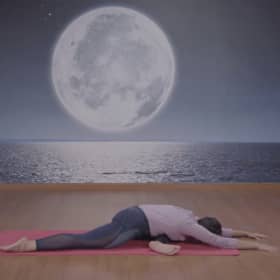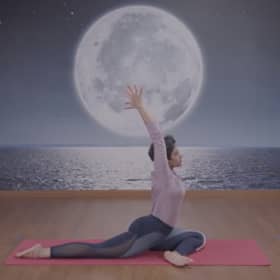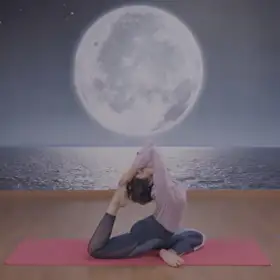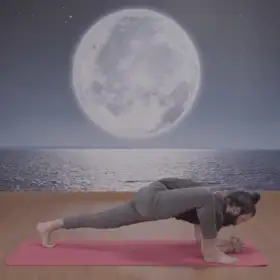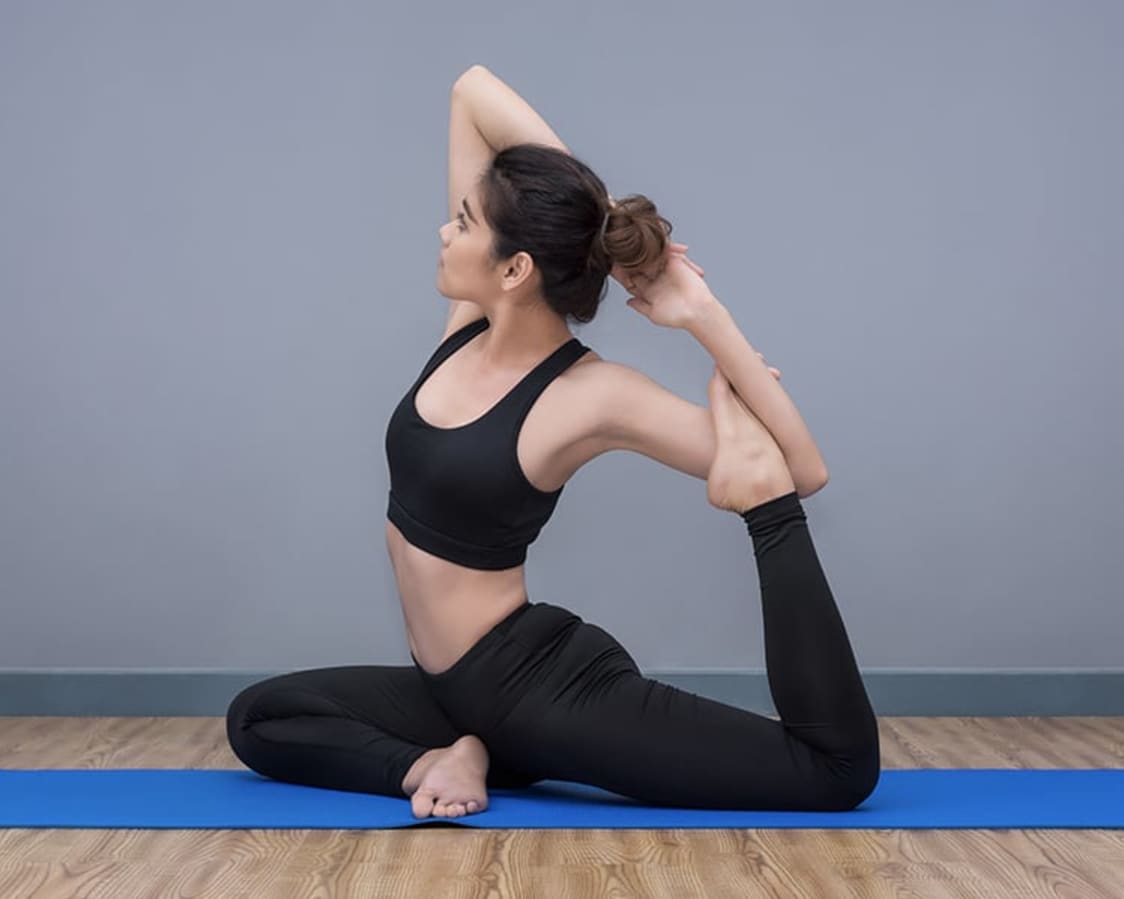
About this pack
6 Videos
What to expect from Seated Postures?
In these sessions, our fitness instructor will take you through 6 different types of asanas such as Ardhamatsendhrasana, Purvottanasana, Rajakapotasana and more.
About Ardhamatsendhrasana:
We will start off with Ardhamatsendhrasana in our first session. Now, Ardhamatsendhrasana is a yoga posture that stretches the back muscles and the spine, alleviates constipation and improves digestion and increases the supply of oxygen to the lungs.
About other yoga asanas:
Once you complete this asana, our instructor will teach you how to do Purvottanasa also known as the table pose. In the successive sessions, she will take you through the other asanas such as Rajakapotasana steps and Purvottanasana steps.
When to perform these asanas:
You can do these asanas anywhere and any time of the day. Listen to your body while performing these postures and don’t be too hard on yourself if you don’t get them right the first time. With regular practice, you too can master these movements. Let’s get started with our first session right away!
What are sitting yoga poses?
The ancient science of yoga is based on the tenet of bringing harmony between not only our mind and the bodies but also with nature. It involves the practice of mental, physical, and spiritual practices that inculcate wellness, relaxation, and physical fitness.
Amongst the various branches of yoga that include the practice of meditation, breath control or pranayama, etc., hatha yoga is what alludes to the physical practice of asanas. These asanas focus on revitalizing one’s energy chakras or energy channels.
Hatha yoga asanas are further divided into various types depending on the position of the body. These involve poses that require you to sit, stand, balance, or twist your body.
Out of all these asanas, sitting yoga poses are described as being the most steady and comfortable. This is not only because these are used to practise meditation and pranayama but are also suitable for almost everyone, even those with postural and flexibility issues. As the name suggests, sitting asanas are those physical positions that require you to be seated on the floor in an erect and cross-legged posture.
Depending on their complexity and intensity, sitting yoga poses are categorised into basic, intermediate, and advanced level poses.
Which are the best sitting asanas?
Here are some of the most effective seated yoga poses that are perfect for practitioners of all ages and levels that help strengthen your body and relax your mind. We have explained sitting asana names along with their benefits and steps:
1. Padmasana (Lotus Pose):
This is a basic yoga pose that opens up your hips and stretches your feet and ankles and improves your posture at the same time. It also helps in calming your mind and improving your awareness and concentration. Here is how to practice this pose:
Sit on the floor with your spine erect and legs stretched in the front.
Gently bend your right knee and place it on your left thigh while keeping your heel close to your abdomen. Repeat on the other side.
Now place your hands on your knees in the mudra position.
Continue sitting while taking long breaths in and out.
Duration: 1-15 minutes
2. Ardha Matsyendrasana (Sitting Half Spinal Twist Pose):
This is one of the best-seated twist yoga poses that improve the flexibility of your spine, relieves back pain, and works on your abdominal muscles. Here is how to do this pose:
Sit on the floor with your legs stretched in the front. Keep your spine erect and feet together.
Bend your left leg gently and place its heel beside your right hip.
Now take your right leg over the left knee.
Place your left hand on the right knee and then take the right hand behind you.
Slowly twist your waist, shoulders, and neck in this particular sequence and look over your right shoulder.
Inhale and exhale gently.
Repeat on the other side.
Duration: 2-5 minutes
3. Vajrasana (Diamond Pose):
This is one of the most effective sitting yoga poses for improving your digestion and keeping your stomach healthy. It can also be combined with meditation and breathing exercises and helps calm your mind.
Sit with your legs stretched in front of you.
Now gently fold your legs and sit in a kneeling position.
Let your toes point out behind you and try to make your big toes touch each other.
Sit comfortably and keep your head, neck, and spine erect.
Place your palms on your thighs.
Hold the pose and inhale and exhale gently.
Duration: 30 seconds- 15 minutes
4. Janu Sirsasana (Head to Knee Pose):
This is one of the best-seated twist yoga pose for helping your liver and kidneys function better. It also enhances your digestion and is known to work great to calm your mind especially when you experience frequent stress and anxiety. Here is how you can do this pose:
Sit on the floor with your legs outstretched.
Gently bend your right knee and place your right foot against the inner part of your left thigh.
Flex your left foot while pressing the top of your thigh down. Raise your arms on either side of your head.
Slowly rotate your upper body so that you are facing your left leg.
Fold forward from your hips while keeping your chest open and shoulders and neck relaxed.
Duration: 10 seconds- 2minutes
5. Paschimottanasana (Seated Forward Bend Pose):
This is a great sitting yoga pose that massages, stretches, and tones your pelvic and abdominal organs. It also makes your shoulders, hips, back, and hamstrings stronger. Here is how you can practice the pose:
Sit with your legs stretched in front while keeping your spine erect.
Slowly raise your arms above your head and stretch your body.
Now bend slowly from the hip joints. Focus on moving towards your toes instead of your knees.
Place your hands on your legs till wherever they stretch and pull yourself forward.
Lift your head slightly and move your navel towards the knees.
Duration: 20 seconds- 2 minutes
6. Bakasana (Crow Pose):
This is one of the advanced sitting asanas that strengthen your hips, thighs, and wrists. It also stretches your upper back and tones your abdomen. This is also a great pose for improving your confidence and focus. Here are the steps that you need to follow:
Start in the squatting position with your knees wide apart and arms on the inner side of your legs.
Stretch your fingers and place your palms on the floor shoulder-width apart in front of your feet while keeping your elbows slightly bent.
Lean forward a little and bring your knees close to the armpits as much as your can.
Start transferring your body weight to your arms while keeping your toes on the floor.
Press your knees against your arms and lift your toes off the floor.
Raise your hips a little and balance your body on your arms.
Raise your head and gaze ahead.
Hold the pose for a few seconds and come back to the floor gently.
Duration: 5-20 seconds
Who can do sitting yoga poses?
Sitting yoga poses are versatile and customisable and can be easily done by a variety of people at different stages of age or health conditions. These include:
Children as young as 7 years can do sitting yoga asanas.
Seniors can easily do sitting yoga poses.
Pregnant women
Those who want to practice yoga pranayam or meditation.
People who experience frequent episodes of stress, anxiety, panic, and depression.
People who want to improve their concentration and focus.
Those who suffer from digestive issues.
People who feel inflammation, stiffness, or pain in their muscles or joints.
Those who are suffering from liver or kidney issues.
People who want to lose weight.
Those who want to improve their balance, flexibility, and coordination.
People who want to tone up and build muscles.
Who should avoid doing these sitting yoga poses?
Sitting asanas should be avoided by:
People who are suffering from fever, cold, or flu.
Those who are suffering from extreme stress, anxiety, or panic.
People who have suffered an injury to their back, legs, arms, or knees and are yet to heal.
Those who have recently undergone surgery and are still recuperating.
Those who are experiencing pain in their legs, calves, ankles, or arms.
People who are fatigued due to lack of sleep or a tiring routine.
Have been diagnosed with heart disease, high blood pressure, hernia, spondylitis, sciatica, or some infectious disease.
What are the benefits of sitting asanas?
Sitting yoga poses involve your body from head to toe and extend benefits to almost all the parts of your body. Not just this, these poses also have amazing spiritual and mental benefits. Here is a rundown on the sitting asanas and their benefits:
Seated yoga poses are great for stretching your lower body including your calves, hamstrings, and hips. This is a great benefit especially for those people who sit for long hours.
Sitting yoga asanas make your spine flexible and improve your range of motion.
They improve your posture and help in reducing neck and back pains.
Sitting yoga poses help in inculcating the habit of meditation and pranayama. These are extremely beneficial in helping you keep calm and peaceful by reducing stress and anxiety. This also helps you react better to stressful situations.
Sitting yoga asanas help in curing digestive issues such as constipation, pains, flatulence, and bloat.
Sitting yoga poses help in reducing pain, stiffness, and inflammation in your joints and muscles. These are especially great for people suffering from rheumatoid arthritis.
When done during pregnancy, these poses help in reducing back pain and discomfort and form an important part of prenatal yoga.
These poses of yoga for women have great benefits such as easing abdominal pain during menstruation, reducing menopause-related discomforts, hormonal imbalances, and mood swings.
Seated yoga poses sequence is great for improving your blood circulation. This helps in enhancing the functioning of your organs, strengthening your muscles, and improving your immunity.
This improved blood circulation through seated yoga poses sequence helps in improving your cognitive abilities and bettering your memory. In the long run, this helps in preventing conditions such as dementia, Alzheimer’s, Parkinson’s, etc.
These poses help in treating insomnia and improving your sleep patterns.
Seated yoga poses are great for making you feel fresh by reducing fatigue and exhaustion.
They help you lose weight and ward off obesity-related health issues.
Are there any disadvantages of sitting yoga poses?
There are no inherent disadvantages of seated yoga poses sequence, just some risks that arise out of not following the correct techniques of these asanas. These include:
Doing sitting yoga poses without understanding and practising the correct technique may result in injuries and soreness in your muscles. It is not just sufficient to know sitting asana names. You need to know the exact steps and sequences too.
Overdoing the poses without adequate breaks in between may lead to stress and fatigue.
What are the dos and don’ts of sitting yoga poses?
Here are some things to keep in mind while doing sitting yoga poses:
Dos:
Always practice in a calm, clean, and well-ventilated space to gain sitting asanas and their benefits. This also inculcates positivity and motivation.
Understand your body and its limitations while doing advanced poses like seated twist yoga poses.
Combine different forms of yoga to keep yourself engaged and motivated to continue your practice. For example, you can combine seated yoga poses with face yoga asanas.
Always include a warm-up and cool-down session before and after your yoga session. This avoids muscular injuries and fatigue.
Practice these asanas preferably early in the morning. This is when your mind is fresh and you can practice yoga calmly.
Switch off your mobile phone and TV to practice these yoga asanas without distractions.
Never overdo these asanas. Always take adequate rest and breaks in between.
Dont’s:
Never do sitting yoga asanas without an experienced trainer’s guidance. Doing the postures incorrectly may not just lead to muscular pain and soreness but also chronic problems and acute pain.
Don’t give yourself unrealistic goals.
Never start too much too soon. Start slow and build up your practise gradually for the best results.
In case you suffer from any health issues, don’t start practising sitting yoga poses without consulting your doctor.
Don’t perform these asanas if you are injured or have undergone recent surgery.
Pregnant women must not do these asanas without consulting their doctor.
Never overstretch while performing these asanas. This may lead to compression or herniation in your muscles or spine.
Don’t practice yoga if you are stressed or anxious. This may increase your heart rate and lead to palpitations and feelings of panic.
Never practice yoga if you have a fever, flu, or cold unless you have recovered fully.
If you are unable to perform an asana, avoid doing it instead of pushing yourself too much.
What are the things required to do sitting yoga poses?
Here are some things that will make your sitting yoga poses more effective:
A yoga mat
A bottle of water
Comfortable and breathable clothing
A DVD or app for instructions.
Top Searches
Cardio Exercise | HIIT Workout | Weight Loss Workout | Six Pack Abs | Exercise To Reduce Belly Fat | Hrx Training | Stamina Increase Exercise | Online Yoga Classes | How To Do Splits | Exercise For Beginners | Dumbbell Workouts | Pilates Exercise | Walk Exercise | Pistol Squats | Oblique Exercises | Full Body Dumbbell Workouts | Back Exercises | Strength Training | Mobility Exercises | Thigh Exercises | Abs Workout | Arms Workout | Chest Workouts | Butt Exercises | Core Exercises
Dalgona Coffee | Chocolate Cake | Donut | Samosa | Mayonnaise | Dhokla | Sprouts | Rasgulla | Spaghetti | Paneer Tikka | Manchurian | Palak Paneer | Chilli Paneer | Daal Makhani | Missi Roti | Vada Pav | Chapati | Chocolate Cupcake | Kaju Katli | Garam Masala
Cult Gyms In India
Gyms In Delhi | Gyms In Mumbai | Gyms In Bangalore | Gyms In Pune | Gyms In Chennai | Gyms In Hyderabad | Gyms In Jaipur | Gyms In Kolkata | Gyms In Ahmedabad | Gyms In Chandigarh | Gyms In Indore | Gyms In Coimbatore | Gyms In Surat | Gyms In Ludhiana | Gyms In Vizag | Gyms In Amritsar | Gyms In Mysore | Gyms In Mangalore | Gyms In Kochi | Gyms In Jammu | Gym In Kharghar | Gym In Bandra | Gym In Velachery | Gym In Chembur | Gym In Indiranagar | Gym In HSR Layout



